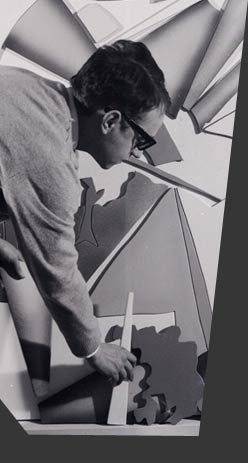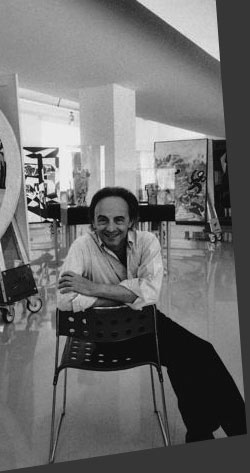Tiziana Andina
BETWEEN LICHTENSTEIN AND WARHOL: UGO NESPOLOâS POP
...It is precisely in this perspective that the artistic production of Ugo Nespolo finds its inspiration. As I mentioned, Nespolo summarises in original ways Lichtenstein's nostalgia for the future and Warhol's somewhat rough realism. Nespolo's works are tales; after all, the idea that art's purpose is mainly to tell a story, be it epic or ordinary, is fully expressed in the symbolic figure of the stylised eye that often appears in his paintings-a second artistic signature, as it were. Nespolo tells his stories with the same exuberance of colour as Warhol but, unlike him, he expresses a dreamy and fantastic surrealism.
...Next to its fairy-tale dimension, Nespolo's Pop also exhibits a militant nature, as it were: he is strongly critical of the excesses of the artworld (see Nespolo 1994, 2012). To that world, which has become an obsessive manufacturer of fleeting fashions and artistic phenomena, Nespolo opposed a very solid idea not only of what art is but also of what its ethical and social dimensions should be. A very efficient example of this is Storie di oggi (1990): both a tribute to Pop Art and a statement. Here Nespolo answers the question "what is art?" in a very precise way: art is one of the most effective tools available to humankind to tell stories, of individuals or communities, of unknown people as well as of whole stretches of human history.
This same idea is expressed in Museo de noantri (2003): a stylised man, an ordinary man, without any hint of specificity to identify him, is watching stories about our history in a museum. He observes stories of kings, pictures of New Dada artists, a series of Fibonacci and a painting by Nespolo - to be precise, an eye. The artist is the one who sees all, like a fabulist, and tells a story of which he is both a part and the external narrator. Nespolo is part of the story he is telling and makes this explicit by hanging his eye, as a painting, in the museum of which he is telling the story. Yet, he is also the external narrator and interpreter of this tale, since his work orientates the meaning of our collective history - the story of the rest of us (noantri).
When art moves away from the practices that make it a public and popular story, when it loses the sense of this narration - Nespolo seems to warn us-it also loses its own sense and meaning, which consists mainly in telling stories and doing it well. This is also the feature that makes art essentially different from disciplines that are close but not identical to it, such as philosophy. And this also seems to be the reason why-after exploring, in the first phase of his work, the possibilities and limits of conceptualism - Nespolo definitely changed direction, taking his art to the heart of collective memory and taste. The artworld may decide to follow the most unlikely and peculiar paths, but the artist fundamentally is and remains a storyteller who has access to the collective memory and is able to talk to the people's shared unconscious.
Art, very simply, is nothing more than that.
(From Aesthetics magazine, n. 5, special issue, supplement to the n. 58, 2015, Rosenberg & Sellier, Torino)



